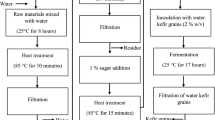Abstract
Fourteen species of keratinophilic fungi belonging to ten genera (Chrysoporium, Malbranchea, Chaetomium,Sepedonium, Microascus, Scopulariopsis, Curvularia, Fusarium, Aspergillus, Penicillium) were isolated from feathers of about one hundred living poultry birds. The isolated fungi were compared for their keratinase activity after growing them on two different media: (1) basal salts solution containing natural keratin (human hair) as the only source of carbon and nitrogen; (2) the medium was supplemented with a minor amount of readily assimilable source of carbon along with natural keratin. All the test fungi could grow on keratinous material, degrading it and releasing sulphydryl containing compounds detected as cysteine, total proteins and extracellular keratinase. Maximum enzyme release by these fungi occurred in the broth supplemented with glucose and vitamins, thereby indicating a correlation between the mycelial biomass and production of proteolytic keratinases.
Similar content being viewed by others
References
Yu RJ, Hormon SR, Blank R. Isolation, Purification of an extracellular keratinase of Trichophyton mentagrophytes. J Bact 1968; 96: 1435–1436.
Grzywnowicz G, Lobarzewski J, Wawrzkiewics K, Wokki T. Comparative characterization of proteolytic enzymes from Trichophyton gallinae and Trichophyton verrucosum. Sabouraudia 1989; 27: 319–328.
Hasija SK, Malviya H, Rajak RC. Keratinolytic ability of some fungi isolated from gelatin factory campus, Jabalpur (M.P). Proc Nat Acad Sci India 1990; Part III, Sec. B: 305–309.
Rajak PC, Malviya H, Deshpande H, Hasija SK. Production and comparative characterization of keratinases from Absidia Cylindrospora and Rhizomucor pusillus. Indian J Microbiol 1991; 31: 243–250.
Malviya HK, Rajak RC, Hasija 5K. In vitro degradation of hair keratin by Graphium penicilloideus; Evidences for sulphytolysis and peptidolysis. Crypto Bot 1993; 3; 197–201.
Kunert J Biochemical mechanism of keratin degradation by keratinolytic fungi. In: Govil CM, Bilgrami KS, Singh D, eds. Platinum jubilee volume of Indian Botanical Society. Meerut, India: Agarwal Printers, 1995: 89–98.
Ramakrishna R, Siraj P, Prakasa Sastry SC. Spectroscopic method for the direct determination of cysteine in the presence of other naturally occurring amino acids. Curr Sci 1979; 48: 815–816.
Lowry OH, Rosebrough NJ, Farr AL, Randall RJ. Protein measurements with folin phenol reagent. J Biol Chem 1951; 193: 265–275.
Oris PS, Gaucher GM. Protease production of thermophilic fungi. Can J Microbiol 1973; 19: 129–133.
Singh C. Studies on keratinophilic fungi on Ghana Birds sanctuary, Bharatpur.[Ph.D. thesis]. Agra: Agra University, 1993.
Ziegler H, Bohme H. Uber die aktive Alkalisierung des Terrains also physioligisches Prinzip bei der keratinolyse durch Dermatophyten. Dermato1 Mschr 1969; 155: 178–181.
McQuade AB. Microbiological degradation of wool. Dermatologica 1964; 128: 266.
Bohme H, Ziegler H. Keratinabbau durch Pilze. Arch Mikrobiol 1967: 57: 93–110.
Deshmukh SK, Agrawal SC. Degradation of human hair by some dermatophytes and other keratinophilic fungi. Mykosen 1985; 28: 463–466.
Rajak RC, Malviya HK, Deshpande H, Hasija SK. Keratinolysis by Absidia cylindrospora and Rhizomucor pusillus: a biochemical proof. Mycopathologia 1992; 118: 109–114
Rajamani S, Hilda A. Proteolytic activity of mycoflora from effluents. J Ind Bot Soc 1988; 264–266.
Takiuchi I, Higuchi D, Takagi H, Koga M. Isolation of an extracellular proteinase (keratinase) from Microsporum canis. Sabouraudia 1982; 20: 281–288.
Kunert J, Keratin decomposition by dermatophytes. I. Sulfite production as a possible way of substrate denaturation. Z Allg Mikrobiol 1973; 13: 489–498.
Yu RJ, Hormon SR, Grappel SF. Two cell-bound keratinases of Trichophyton mentagrophytes. J Invest Dermatol 1971; 56; 27–32.
Kunert J. Biochemical mechanism of keratin degradation by the actinomycete Streptomyces fradiae and the fungus Microsporum gypseum: a comparison. J Basic Microbiol 1989; 29: 597–604.
Kunert J. Effect of reducing agents on proteolytic activity of enzymes of Microsporum gypseum. Mycoses 1992; 35: 343–348.
Meevootism V, Niederpruem DJ. Control of exocellular proteases in dermatophytes and especially Trichophyton rubrum. Sabouraudia 1979; 17: 91–106.
Frey D. Isolation of a new species of Aleurisma from soil in Australia and New Guinea. Mycologia 1959; 51: 641–646.
Barron GL, Cain RF, Gilman JC. The genus Microascus. Can J Bot 1961; 39: 1609–1631.
De Vries GA. Ascomycetes: Eurotiales, sphaeriales, and Dothidia1es. In: Howard DH, ed. Fungi pathogenic for humans and animals, Part A. New York: Marcel Dekker, Inc., 1983: 81–111.
Fragner P, Belsan I. Scopulariopsis Bainier as causative agent of onychomycoses. Mycological and clinical study. Acta Univ Carol Med 1974; 20: 333–353.
Onsberg P. Scopulariopsis brevicaulis in nails. Dermatologica 1980; 161: 259–264.
Mahgoub ES. Mycetomas caused by Curvularia lunata, Madurella grisea, Aspergillus nidulans and Nocardia braziliensis in sudan. Sabouraudia 1973; 11: 179–182.
Author information
Authors and Affiliations
Rights and permissions
About this article
Cite this article
Kaul, S., Sumbali, G. Production of extracellular keratinases by keratinophilic fungal species inhabiting feathers of living poultry birds (Gallus domesticus): A comparison. Mycopathologia 146, 19–24 (1999). https://doi.org/10.1023/A:1007086720237
Issue Date:
DOI: https://doi.org/10.1023/A:1007086720237




